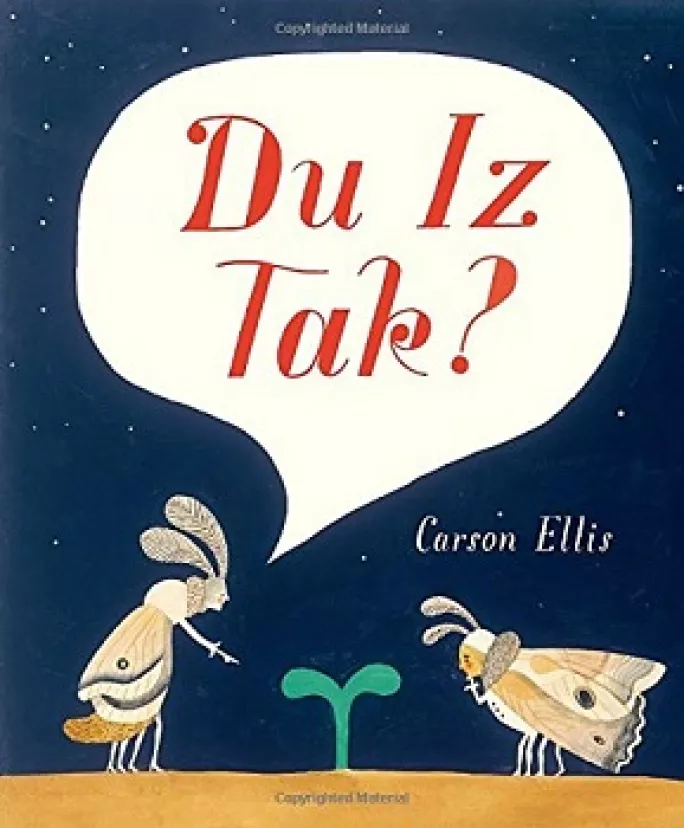- Home
- ‘There is no writing - just spellings’: the class book review
‘There is no writing - just spellings’: the class book review

Title: Du Iz Tak?
Author and illustrator: Carson Ellis
Publisher: Walker Books
Teacher and pupil review
Don’t be put off by the title of this new picture book, written and illustrated by Carson Ellis. I was. If I am honest, Du Iz Tak? is not a book I would have picked up in the bookshop or chosen to read to a class. My mistake.
The Year 2 class loved it, from the moment they saw the front cover and quirky title. Many tried to read the title before I did, and were already looking at me quizzically. George commented: “This is very confusing. There is no writing - just spellings”.
When Du Iz Tak? arrived, I thought there had been a mistake, and that I had erroneously been sent a story in another language. The book is written in the mysterious language of insect, and tells the story of the lifecycle of a flower through the insects who observe this miracle of nature.
This use of non-words is made possible by the strong, bold illustrations that narrate the story through pictures. The illustrations show the plant starting as a tiny green shoot, before blooming into a magnificent flower and finally fading back to the ground. (A cautionary note: keep turning the pages to the very end, as there is a surprise. Another green shoot appears on the final credit page, as the lifecycle of the flower miraculously begins again.)
As Sophia commented: “That little plant just keeps on growing and growing.”

Reading in insect
Alongside this story is one about the changes the insects go through, as the unappealing caterpillar spends most of the book changing inside a cocoon. Olivia quite rightly said: “They won’t see him again until he is a butterfly.”
Near the end, the cocoon splits to reveal a beautiful girl insect, who dances to the music played by the similar nocturnal boy insect. “I think he is trying to use the music so the cocoon will wake up,” said Taylor-Mai.
The arrival of the spider in the garden causes some concern among the insects - and also among the children listening - until the idea of food chains is developed, and a large bird is seen disappearing off the page with the spider in its beak. “That’s really sad,” said Tom. “When the spider gets eaten by the bird and the spiders dangling legs are hanging out its beak.”
It was definitely a personal challenge, reading aloud in insect (a salutary reminder of the painful reading - with little understanding - from my own school days). As an adult, I was able to use the punctuation to add some inflection to my reading - I hadn’t realised how helpful ? and ! are when you can’t understand words.
As I read on, I realised: this book is genius. The children in front of me continued to erupt into gales of laughter at the lyrical-sounding nonsense words. They also knew exactly what was happening through the pictures.
Great practice for reluctant readers, a book written in insect can be read by anyone. Phonics was the only available strategy for decoding this book - a marvellous and unexpected teaching point. “Can you buy more of them so that when we change our library books we could get that one?” asked Heidi.
Ribble
Knowing that I needed to put my game face on and give this book a fair crack with the children, I decided to read it through with them twice: the first time so they could enjoy the words and the pictures and the second time so we could discuss what was happening as we went along.
The second reading had the children tumbling out their ideas: the plants were growing; the plants start as a seed, something eats it, it is a lifecycle; they are speaking a different language.
We began to discuss what the words meant and had a go at translating insect - what did the phrase “du iz tak?” mean? We guessed: “What is that?” Then we worked out that “su” must mean “yes” and “ribble” must be “ladder” and on we went, with the children’s innate desire to make sense of the words driving the discussion.
The children were so caught up in this original book, with its quirky language and delightful illustrations, that my initial reservations were completely forgotten.
‘It’s got, like, jokes’
Joe said: “I liked all the funny words and the expressions. It made me laugh a lot.”
“I would buy it because it is really, really nice,” said Bobby.
Reuben commented: “I liked it when they put all the equipment on the plant.”
And Dexter thought his little brother would like it too: “I would buy it as it has got, like, jokes.”
I loved the book by the end, too, and a copy will most certainly be joining other favourites on my book shelf. What a find - highly recommended by all.
Jane Flood is Reception teacher at Copythorne CE Infant School, in Southampton.
If you or your class would like to write a review for TES, please contact Adi Bloom on adi.bloom@tesglobal.com
Want to keep up with the latest education news and opinion? Follow TES on Twitter and like TES on Facebook
Keep reading for just £1 per month
You've reached your limit of free articles this month. Subscribe for £1 per month for three months and get:
- Unlimited access to all Tes magazine content
- Exclusive subscriber-only stories
- Award-winning email newsletters



